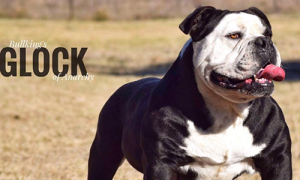 Understanding the basic Olde English Bulldogge “breed standard” is the cornerstone of every breeding program and should be the light by which every breeder is guided. Unfortunately, in many cases, backyard breeders simply “hook” two dogs up and call it good. Chris and I carefully “marry” each breeding pair to take advantage of both dogs’ strong suit, while fixing any flaws. In theory, if a breeder’s breeding program is working, they should be producing better and better generations. It all starts with the BREED STANDARD!
Understanding the basic Olde English Bulldogge “breed standard” is the cornerstone of every breeding program and should be the light by which every breeder is guided. Unfortunately, in many cases, backyard breeders simply “hook” two dogs up and call it good. Chris and I carefully “marry” each breeding pair to take advantage of both dogs’ strong suit, while fixing any flaws. In theory, if a breeder’s breeding program is working, they should be producing better and better generations. It all starts with the BREED STANDARD!
General Description:
Their lifespan is between 10 and 14 years.
Head: Large and high, moderately sunken between the eyes (medial furrow). The circumference of the head should be equal to or greater than the dog’s height at the shoulder. A narrow head or one that appears too small for the body is a fault.
Ears: Rose ears set well on the sides of the head are preferred. Dropped ears are acceptable as long they are small, not “hound like”. Full pricked ears that stand up on top of the head should be considered a serious fault.
Muzzle: Broad, deep, and short with moderate wrinkling. The bite is undershot with the bottom jaw turning up noticeably. Lower canines should not protrude. Muzzle too long (more than 3 inches), scissor bite, or even bite are disqualifying faults. The muzzle should be no shorter than 1 ½”. Wry jaw is a disqualifying fault.
Eyes: Wide apart and of moderate size. Any color is acceptable. However, odd eyes (one dark, one blue or light) should be considered non preferred. Misshapen or bugged eyes are a serious fault. Lacking pigment around the eyes is undesirable. Crossed eyes or non-symmetrically shaped eyes are a disqualifying fault.
Nose: Broad with open nostrils (nares) with no sign of air restriction. The nose should not be pushed up between the eyes. From the stop to the end of the nose must be at least one and one-half inches. The nose should be a solid color. Lacking pigment is a serious fault. A nose lacking all pigment is a disqualifying fault.
Neck: Short to medium in length and very muscular flowing into the shoulders and should not be set on the dog so it appears to stop at the shoulders.
Chest: Ribs should be well sprung (rounded) and the chest wide and deep.
Depth of chest should be at least to the elbows. A hollow or narrow chest (slab-sided) should be considered a serious fault.
Back: Males should appear square and balanced. Females should appear similar with consideration given for body length. Short with a very slight rise from the shoulders to a slight drop in the croup is preferred. A level back is acceptable as long as the tail does not come straight off the top of the back.
Shoulders: Shoulders should be well laid back with significant angulations to allow for good movement. Straight shoulders are a fault.
Legs: Forelegs should be straight and wide apart, neither bowing out nor turning in. There should be a significant bone substance. Elbows should be relatively close to the body. Lacking bone and substance is very undesirable. Elbows that are loose or “fiddle fronts” are a disqualifying fault. “East / West” forelegs are a serious fault.
Rear legs should exhibit significant bend of stifle so as to allow for good movement. They should be well muscled. Straight or “posty” rear legs are a serious fault. Cow hocks are a disqualifying fault.
Movement: Dogs should have a balanced gait that drives off the rear and is complimented by reach allowing the dog to cover ground with a sense of power. Dogs should single track. Pacing or crabbing is a serious fault.
Feet: Round, tight both front and rear, and the pasterns should be strong.
Weak pasterns and/or splayed feet are disqualifying faults.
Height: Males – 18 to 20 inches at the shoulder. Females – 17 to 19 inches at the shoulder.
Weight: Between 50 to 70 lbs. for females and 65 to 85 lbs. for males. Although height and weight above the standard are to be discouraged, there is no penalty as long as the dog is well proportioned, otherwise correct and balanced.
Color: Any color is acceptable with no preference for one over another.
Coat: The coat is short. A wavy coat or a long coat is a disqualifying fault and should not be registered. There should be no signs of feathering on the legs, ears, or neck area, this is a disqualifying fault and should not be registered. OEBS with any sign of long or wavy coats is NOT to be registered.
*** Any breeder that registers long-coated OEBS or their decedents are doing so fraudulently and against the IOEBA’S policies. All OEBS registered fraudulently will have their registration revoked as the IOEBA becomes aware of said registration.
Tail: A pump handle tail that naturally reaches the hock is preferred, screwed short or a docked tails are acceptable. The pump handle tail should be carried low and not over the back of the dog.
Temperament: Disposition should be outgoing and happy. While a watchful nature may be expected at home, human aggression without provocation is a disqualifying fault.
For additional information about the Olde English Bulldogge, Crooked Star Bulldogges or any puppies we may have available, contact Bernie Keasler